Bites & Stings
Bites and stings usually occur during the warmer months. The warm weather sends most of us outdoors and increases our exposure to bees, spiders, caterpillars, and snakes. These animals use poisonous venom as a means to capture prey or defending of themselves or nesting areas. Take time to practice prevention and learn first aid. The West Virginia Poison Center is available 24 hours a day to help you if a bite or sting occurs.
BEES & WASPS
Bees and wasps usually will avoid contact with humans unless threatened. When a bee or wasp flies close, don't swat it away. A slow, quiet retreat out of harm's way is the best move. Avoid wearing bright colors, clothing with flower patterns, and heavily scented perfumes and hair sprays. Some plants such as clover and fruit trees, attract bees and wasps. Keep away.
CATERPILLAR
LATE SUMMER-EARLY FALL
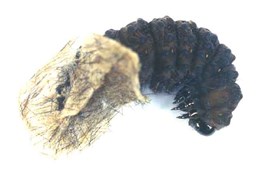 Enjoy their beauty, but stay away.
Enjoy their beauty, but stay away.
“It was so cute and fuzzy I just had to touch it”…your exploring child is now screaming in pain.
“I’ve never seen something like this before, I just wanted to pick it up so someone else could see it too”…your hand is now red and you are in pain.
“All I was doing was working in the yard and a caterpillar dropped on me”…the back of your neck or hand is now red, itchy, and hurts like crazy.
Sound familiar?
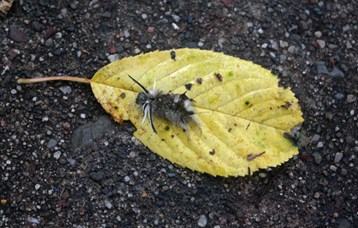 Some of the caterpillars found in West Virginia can cause itchy reactions or painful stings. Examples specific to this state include the: saddleback caterpillar, stinging rose caterpillar, Hagmoth caterpillar (Monkey slug), Io moth caterpillar, tussock moth caterpillar, and puss caterpillar. Human contact with the puss caterpillar is not common but it is the caterpillar notorious for causing the most amount of pain for the longest amount of time. The puss caterpillar’s soft fur-like appearance can make the desire to touch them hard to resist (an original Star Trek fan would say they look like small Tribbles). West Virginia’s stinging caterpillars like broad leaf trees (maples, oaks for example); the puss caterpillar likes trees and plants such as elms, rose bushes, and ivy.
Some of the caterpillars found in West Virginia can cause itchy reactions or painful stings. Examples specific to this state include the: saddleback caterpillar, stinging rose caterpillar, Hagmoth caterpillar (Monkey slug), Io moth caterpillar, tussock moth caterpillar, and puss caterpillar. Human contact with the puss caterpillar is not common but it is the caterpillar notorious for causing the most amount of pain for the longest amount of time. The puss caterpillar’s soft fur-like appearance can make the desire to touch them hard to resist (an original Star Trek fan would say they look like small Tribbles). West Virginia’s stinging caterpillars like broad leaf trees (maples, oaks for example); the puss caterpillar likes trees and plants such as elms, rose bushes, and ivy.
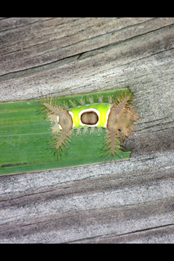 Unlike bees, caterpillars do not intentionally sting. The setae (hairs) which are like hollow spines can break off upon contact and enter the skin or the poison sac at the base of the hairs can break open when the hairs are brushed off causing the poison to leak out onto the skin. Some caterpillars do not have poison sacs under the setae (hairs) but the hairs themselves cause itchy reactions.
Unlike bees, caterpillars do not intentionally sting. The setae (hairs) which are like hollow spines can break off upon contact and enter the skin or the poison sac at the base of the hairs can break open when the hairs are brushed off causing the poison to leak out onto the skin. Some caterpillars do not have poison sacs under the setae (hairs) but the hairs themselves cause itchy reactions.
The majority of fuzzy caterpillars are not toxic. These caterpillars trick their prey by looking like caterpillars that do sting. A classic example in West Virginia is the woolley bear caterpillar. However, unless you want to conduct your own experiments on yourself to determine whether or not the caterpillar you just found is the stinging type, the best rule of thumb is to avoid touching any caterpillar with barbs or hairs. Another word of advice: dead stinging caterpillars and their shed skin or cocoons can still cause redness, pain, and itching! Do not touch these with your bare hands. Make sure your children also know not to touch them. Wide brim hats and long sleeves with gloves may help avoid accidental contact when gardening near trees and bushes this time of year.
MOSQUITOES
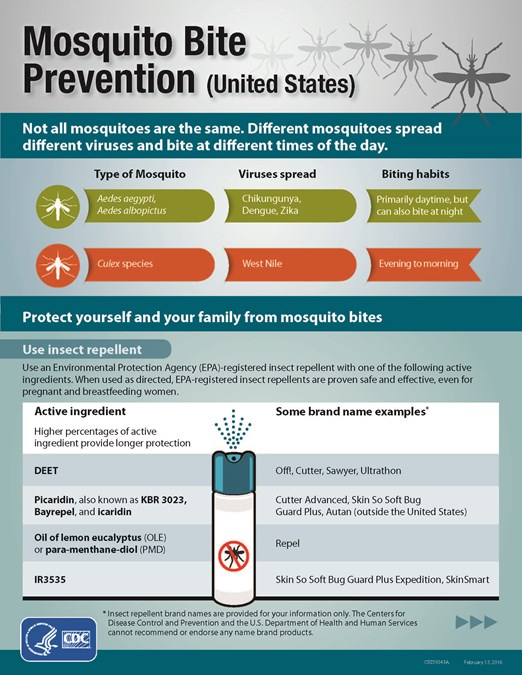
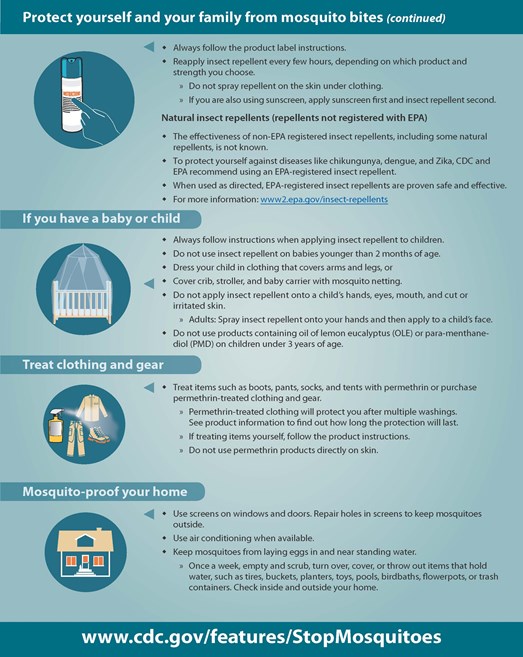
SNAKES
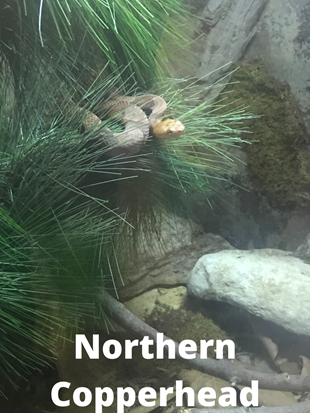
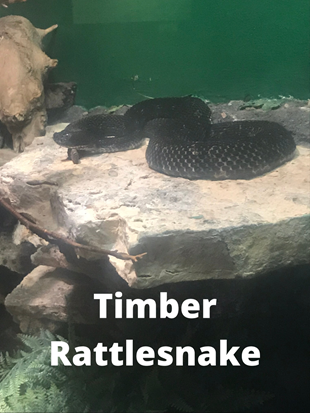
The most hated creatures in West Virginia are probably snakes. Yet of the 22 types (20- species and 2 subspecies) of snakes in this state only two are poisonous, the northern copperhead and the timber rattlesnake. All other snakes are harmless; but if you are bitten by any snake, be sure that your tetanus shot is up to date.
Snake Bite First Aid:
- Remove constrictive items, such as rings.
- Immobilize bitten extremity.
- Keep the person bitten calm.
- Transport to the nearest emergency department.
- Call the West Virginia Poison Center.
No tourniquet, ice, or cutting.
If you do not want snakes around your house, here are some suggestions:
- Keep lawns and fields closely mowed. This will make it less attractive to snakes.
- Eliminate shelter for snakes. Snakes hide under boards, flat rocks, and trash piles.
- Snakes eat rodents. So to keep snakes away, make all outbuildings rodent proof.
SPIDERS
There is only one spider in West Virginia that is harmful to humans. This spider is the black widow. Bites from all of the other spiders can result in mild redness and pain. Recommended treatment for these bites are: clean the area with soap and water then apply a cool compress over the affected area. Call the poison center or your family physician if symptoms are more severe or if you suspect you have been bitten by the black widow, call the poison center.
Prevent spider bites by keeping attics, garages, and basements clean. Dispose of old storage boxes. Carefully shake out stored clothing or shoes before putting them on. Avoid reaching into dark closets, boxes or other places where spiders may live without looking first. As a rule, a bite from a spider means that the victim interfered with a nesting area.
BROWN RECLUSE SPIDERS
Brown? Violin-like marking? 8 legs? Must be a brown recluse spider, right? WRONG!
Brown recluse spiders are not native to WV. While a small tip of the western edge of WV is near areas brown recluse spiders are native, they have never been native to WV.
If in an area where brown recluse spiders are native, they will not be out in the open and will be most active at night.
How much do you know about snakes?
1. How many species of snakes are found in West Virginia?
a. 13
b. 5
c. 20
2. True or False: The size range for snakes in West Virginia is from 10 inches to more than six feet in length.
3. How many species are poisonous/venomous?
a. 2
b. 1
c. 4
4. If bitten by a poisonous/venomous snake, either apply a tourniquet or use the "cut and suck" method.
5. True or False: The length of the Northern copperhead's fangs is related to the length of the snake.
Answers:
1. c. 20
2. True.
3. a. 2
4. False
5. True

